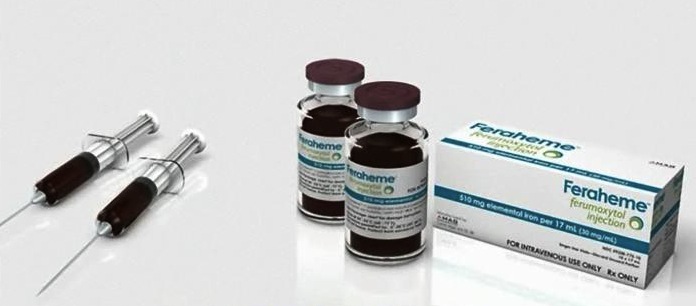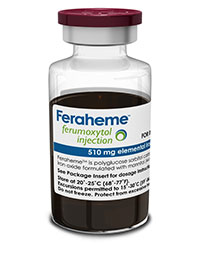By Yael Waknine
Medscape Medical News

July 2, 2009 — On June 30, the US Food and Drug Administration approved ferumoxytol injection (Feraheme, AMAG Pharmaceuticals, Inc) for the treatment of iron deficiency anemia in adult patients with chronic kidney disease.
The injection is expected to be available during the second half of July 2009 and will be marketed in 17-mL single-use vials containing 510 mg of elemental iron. An initial 510-mg intravenous injection, delivered at a rate of up to 1 mL/second (30 mg/second), should be followed by a second 510-mg dose given 3 to 8 days later. Additional 510-mg doses may be administered to patients with persistent or recurrent iron deficiency anemia.
FDA approval of the product was based on data from 3 randomized, open-label controlled clinical trials (n = 1726) that also included an uncontrolled, follow-up phase in which patients with persistent anemia could receive 2 additional doses.
Results showed that ferumoxytol yielded significantly greater mean increases in hemoglobin levels from baseline at day 35 compared with oral iron (ferrous fumarate, 200 mg elemental iron/day) in patients with all stages of chronic kidney disease.
"[The drug] offers patients across the continuum of chronic kidney disease, including patients not on dialysis and patients on dialysis, a new paradigm for the treatment of iron deficiency anemia," commented Brian J.G. Pereira, MD, president and chief executive officer of AMAG Pharmaceuticals, in a company news release.
The most common adverse reactions (incidence ? 2%) reported in clinical trial patients receiving ferumoxytol included diarrhea (4.0% vs 8.2% for iron tablets), nausea (3.1% vs 7.5%), dizziness (2.6% vs 1.8%), hypotension (2.5% vs 0.4%), constipation (2.1% vs 5.7%), and peripheral edema (2.0% vs 3.2%).
Because of the potential for hypersensitivity reactions and hypotension, patients should be observed for at least 30 minutes after each dose. To avoid iron overload and the potential for iatrogenic hemosiderosis, patients should be regularly monitored for hematologic response, with the caveat that serum and transferrin-bound iron values may be overestimated by laboratory assays performed during the first 24 hours.
As a superparamagnetic iron oxide, ferumoxytol can alter magnetic resonance imaging studies for up to 3 months after the last dose. X-ray, computed tomography, positron emission tomography, single photon emission computed tomography, ultrasound, and nuclear imaging are not affected.
According to the news release, the company will fulfill requirements of the Pediatric Research Equity Act by conducting 2 postmarketing studies of ferumoxytol in pediatric patients with chronic kidney disease both requiring and not requiring dialysis. About 150 patients will be enrolled in the studies, which are slated to begin in 2010.
The company notes on its Web site that ferumoxytol is currently being developed to treat iron deficiency anemia in women with abnormal uterine bleeding and in patients with cancer and gastrointestinal diseases. Because of its potential to improve the visualization of blood vessels, ferumoxytol may also be useful as a diagnostic agent for vascular-enhanced magnetic resonance imaging to assess peripheral arterial disease.
別擔心,我知道你們不喜歡看英文:
July 2, 2009 — 美國食品藥物管理局(FDA)於6月20日核准ferumoxytol注射劑(Feraheme,AMAG藥廠)用於治療成人慢性腎臟疾病患者的缺鐵性貧血。
該注射劑預計於2009年7月下旬上市,上市的產品為17 ml的單次使用劑型,內含510 mg的元素鐵。起始使用510 mg的注射劑,以1 ml/sec的速度注射(30 mg/sec),接著在3~8天後注射第二次510 mg的劑量。若病患持續性貧血、或貧血再發可以接受額外的510 mg劑量注射。
FDA根據三項隨機分派、開放標記、控制組控制研究(受試者人數共1726位)核准了這項藥品,這些研究包括持續性貧血且可以接受另外兩次劑量病患的未控制、後續追蹤期。
結果顯示,相較於口服鐵劑,ferumoxytol在注射後35天時可以顯著增加所有期別慢性腎臟疾病患者血紅素平均值(ferrous fumarate,每天200 mg元素鐵)。
AMAG藥廠的總裁與總經理Brian J.G. Pereira醫師評論,這個藥物提供不同期別慢性腎臟疾病患者,包括未接受透析或正在接受透析患者,一個治療缺鐵性貧血的新選擇。
臨床研究中,接受ferumoxytol患者最常見的副作用(發生率>2%的)包括腹瀉(ferumoxytol為4.0%,口服鐵劑則是8.2%)、噁心(3.1%相較於7.5%)、頭暈(2.6%相較於1.8%)、低血壓(2.5%相較於0.4%)、便秘(2.1%相較於5.7%)、以及週邊水腫(2.0%相較於3.2%)。
由於潛在的過敏反應與低血壓,在每次注射後,病患都應該接受至少30分鐘的觀察。為了避免鐵過量或是醫源性血鐵質沉著的潛在可能性,病患應該常規地接受血液反應的監測,要注意在頭24小時進行實驗室檢驗可能會高估血漿與運鐵蛋白結合的鐵濃度數值。
雖然最後一次劑量在3個月前投予,但作為超順磁性氧化鐵,ferumoxytol會影響核磁共振造影結果。X射線、電腦斷層掃描、正子攝影、單一質子電腦斷層、超音波、與核醫造影並不會受到影響。
根據新聞稿,該公司將會達到兒童研究公平法案的要求,針對兒童慢性腎臟疾病患者,不論是否需要接受透析,進行兩項ferumoxytol的上市後研究。大約將有150位病患被收納到這些研究,預定將在2010年開始進行。
該公司在他們的網站上表示,ferumoxytol目前正被研發用於治療異常子宮出血女性的缺鐵性貧血,以及癌症及腸胃道疾病病患。因為其改善血管視覺化的潛力,ferumoxytol也可用於血管增強核磁共振造影,以評估周邊動脈血管疾病的診斷用藥。







 留言列表
留言列表
 線上藥物查詢
線上藥物查詢 